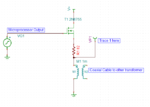ErikG
Newbie level 4
hey all,
I am working on a project and i am having an issue i hope you can help with.
I am driving a square wave signal into a primary of a transformer and using this to inductively couple a signal into a power line, in this case the power line is only 12v. The output of a processor is used to drive a FET and this in turn switches 10v into the primary of the transformer. I have a resistor(82ohm) in series with the output of the fet for current limiting.
If you direct your attention to the scope capture below, have a look at the blue(top) trace. This is the input to the transformer, after the resistor. Is this effect caused by capacitance, or inductance in the transformer or a bit of both? is there a way that i can get a more square wave into this transformer using a LC circuit of some kind? I am inclined to believe that the shape of this signal is affecting the amount of energy getting coupled to the secondary and is causing distortion on the receive side. The square waves are carrying data modulated via FSK.

Thank you for you time, ill check back frequently and answer any questions.
-Erik
I am working on a project and i am having an issue i hope you can help with.
I am driving a square wave signal into a primary of a transformer and using this to inductively couple a signal into a power line, in this case the power line is only 12v. The output of a processor is used to drive a FET and this in turn switches 10v into the primary of the transformer. I have a resistor(82ohm) in series with the output of the fet for current limiting.
If you direct your attention to the scope capture below, have a look at the blue(top) trace. This is the input to the transformer, after the resistor. Is this effect caused by capacitance, or inductance in the transformer or a bit of both? is there a way that i can get a more square wave into this transformer using a LC circuit of some kind? I am inclined to believe that the shape of this signal is affecting the amount of energy getting coupled to the secondary and is causing distortion on the receive side. The square waves are carrying data modulated via FSK.

Thank you for you time, ill check back frequently and answer any questions.
-Erik
